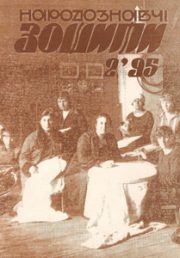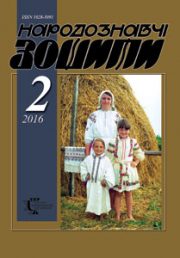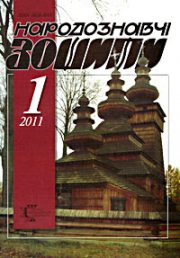The Ethnology Notebooks. 2023. № 3 (171), 614—622
UDK 398.332.42(477.86=161.2)”185/202″
DOI https://doi.org/10.15407/nz2023.03.614
THE SPECIFICS OF WINTER RITUALS OF THE POKUTTIA PEOPLE: NEW YEAR’S CUSTOM «BULLS»
ROMANIV Mykhailo
- ORCID ID: https://orcid.org/0000-0003-0898-4350
- Graduate student of the Department of Ethnology
- of the Ivan Franko National University,
- 1, Universitetska St., 79000, Lviv, Ukraine,
- Contacts: e-mail: romaniv0210@gmail.com
Abstract. The article is dedicated to the analysis of one of the characteristic features of the winter calendar and household rituals of the autochthons of the historical and ethnographic region of Pokuttya is the custom of «walking with bulls». Based on the author’s field ethnographic materials, the structure of the rite was reconstructed.
The New Year’s tradition of visiting villages by boys with wooden toy figurines «bulls» pursued two goals: wishing the owners well-being, first of all ensuring the offspring of livestock and divination for the coming year. The local specificity of the custom (depending on the specific area) is clearly expressed, which is manifested at different levels: from the manufacturing technology and artistic design of «bulls», their number, thematic spectrum and folk semiotics to methods of divination, symbolic theft of figurines and options for their further use.
It was also found that «walking with bulls» on the eve of the New Year had an important productive value, because it was aimed at breeding livestock, as the main symbol of the prosperity of the peasant economy.
The peculiarity of the custom is that it is widespread mainly on the territory of the former Snyatinsky district, partially in the Horodenkivskyi and Kolomoiskyi districts of Ivano-Frankivsk region. In some villages of Pokuttia, the New Year’s fortune-telling game continues to exist to this day, although local people interpret it primarily as a children’s game and a kind of entertainment.
Keywords: Pokuttia, Snyatynshchyna, Kolomyshchyna, Horodenkivshchyna, winter calendar and household rituals, New Year, «bulls», custom, divination.
Received 30.05.2023
REFERENCES
- Kharchyshyn, O. (2017). Calendar-ritual folklore of Pokuttia: durability and changeability of tradition. The Ethnology notebooks, 1, 61—74 [in Ukrainian].
- Serebryakova, O. (2017). «Now Melani, tomorrow Vasyli…» (a fragment of the winter ritual of the Pokuttian people). The Ethnology notebooks, 2, 355—367 [in Ukrainian].
- Kolberg, O. (1882). Pokucie: Obrazy etnograficzne (Vol. I).Krakow: W drukarni uniwersytetu Jagielloсskiego [in Polish].
- Belous, M. (1907). Malanka. People’s parade on the eve of St. Basil and the New Year. Kolomyya [in Russian].
- (2016). Archive of Ivan Franko National University of Lviv. F. R-119. Op. 17. Reference 585-E (Field ethnographic materials on the topic «Traditional winter calendar and household rituals of Ukrainians», recorded by Romaniv Mykhailo Hryhorovych in Snyatyn District, Ivano-Frankivsk Region, June 28—July 10, 2016) [in Ukrainian].
- Temchenko, A.I. (2015). Traditional mantic practices: the archaic sign system. Cherkasy: IntroligaTor [in Ukrainian].
- (2018). Archive of Ivan Franko National University of Lviv. F. R-119. Op. 17. Reference 651-E (Field ethnographic materials on the topic: «Traditional Winter Calendar and Household Rituals of Ukrainians», recorded by Romaniv Mykhailo Hryhorovych in the Kosiv and Kolomyya districts of the Ivano-Frankivsk region. 06.06—07.08.2018) [in Ukrainian].
- Pankiv, M. (1995). Pokutsky «bulls». Berehynia, 3—4, 133—136 [in Ukrainian].
- Kireeva, R. (2014). New Year’s children’s fortune-telling game «bulls». Yamhoriv: literary, local history and artistic almanac (Part 24—25, pp. 286—289). Yamhoriv [in Ukrainian].
- Kupchynskyi, B. (2001) Vikno: The history of the village from ancient times to the present day. Ivano-Frankivsk: Siversiya [in Ukrainian].
- Serebryakova, O. (2017). Symbolic and functional features of ritual attributes in cleromantic actions of Pokuttians. The Ethnology notebooks, 1, 85—98 [in Ukrainian].
- Siletskyi, R. (2006). A child in the traditional construction rituals of the Polischuks. Ethnological notebooks, 3—4, 356—363 [in Ukrainian].
- Kowalski, P. (1996). Child. Paradise Innocence, Divination, Magic: An Introduction to Character Reading. Folk Literature: Scientific and literary bimonthly, 4—5, 19—30 [in Polish].
- Huyvanyuk, N.V. (Ed.). (2005). Dictionary of Bukovinian idioms. Chernivtsi [in Ukrainian].
- Kobalchynska, R. (2004, january 15—21). Pokutsky «bulls», «stallions». Folk children’s divination in Pokuttia and Bukovyna. The Word of Enlightenment, 3 (223), 12—13 [in Ukrainian].
- Mohoruk, D. (2008). My village Toporivtsi. Ethnographic image of the village (Vol. 6). Kosiv: Written Stone [in Ukrainian].
- Mroczko, K. (1897). Sniatyn Land. (Contribution to national ethnography) (Vol. XXV, pp. 289—304). Lwow [in Polish].
- Hlushko, M. (2000) Veal in the Christmas and New Year rituals of Ukrainians: reconstruction of the original image and historical content. Bulletin of Lviv University. The series is historical, 35—36, 399—425 [in Ukrainian].
- Gerus, L. (2015). Folk toy of Pokuttia. Ethnological notebooks, 5, 1072—1085 [in Ukrainian].
- Marchuk, V.V., Marchuk G.I., & Marchuk N.V. (2010). Torgovytsia. Pages of history. Ivano-Frankivsk: Lik [in Ukrainian].
- Herodotus, & Biletskyi, A.O. (1993). Stories in nine books. Kyiv: Naukova dumka [in Ukrainian].
- Publius Cornelius Tacitus. About the origin of Germans and the location of Germany. Retrieved from:https://www.many-books.org/auth/5405/book/15247/tatsit_publiy_korneliy [in Russian].
- Vinohradova, L.N., & Tolstoy, N.I. (Ed.). (1995). Divination. Slavic Antiquities: Ethnolinguistic Dictionary: in 5 vol. (Vol. 1: A—G, pp. 482—486). Moscow: International Relations [in Russian].
- Makhnovets, L.E., & Myshanych, O.V. (Ed.). (1989). Russian Сhronicle. Kyiv. Retrieved from: http://litopys.org.ua/litop/lit.htm [in Ukrainian].
- Berezovska, V. (2017). Winter holidays of the Moldovans of Bessarabia in the 19th century (based on the materials of «Kyshiniv Diocesan Information»). Scientific Bulletin of the Izmail State Humanitarian University. Series «Historical Sciences» (Vol. 37, pp. 156—160) [in Ukrainian].







